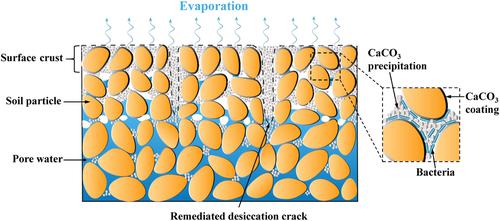当前位置:
X-MOL 学术
›
Water Resour. Res.
›
论文详情
Our official English website, www.x-mol.net, welcomes your
feedback! (Note: you will need to create a separate account there.)
Potential Drought Mitigation Through Microbial Induced Calcite Precipitation-MICP
Water Resources Research ( IF 4.6 ) Pub Date : 2021-09-10 , DOI: 10.1029/2020wr029434 Bo Liu 1 , Chao‐Sheng Tang 1 , Xiao‐Hua Pan 1 , Cheng Zhu 2 , Yao‐Jia Cheng 1 , Jin‐Jian Xu 1 , Bin Shi 3
Water Resources Research ( IF 4.6 ) Pub Date : 2021-09-10 , DOI: 10.1029/2020wr029434 Bo Liu 1 , Chao‐Sheng Tang 1 , Xiao‐Hua Pan 1 , Cheng Zhu 2 , Yao‐Jia Cheng 1 , Jin‐Jian Xu 1 , Bin Shi 3
Affiliation

|
Extreme drought events occur more frequently due to climate change. Soil water loss through evaporation is therefore significantly intensified. This study introduces an environment-friendly and sustainable bio-mediated technique, known as microbially induced calcite precipitation (MICP), for water evaporation suppression in clayey soils. Through lab-scale evaporation tests, we investigate the effects of cementation solution concentration (0.5, 1.0, and 1.5 mol/L) and MICP treatment procedure (one-phase and two-phase MICP methods) on both macroscale (e.g., water loss, desiccation cracking) and microscale (e.g., microstructure variations) behaviors of soils. Experimental results show that MICP is capable of improving water retention capacity and enhancing the inter-particle bonding of clayey soils. Both water evaporation rate and total water loss decrease with the increasing concentration of cementation solution and the number of MICP treatment cycle. For most testing samples, both one-phase and two-phase MICP treatment methods have a similar influence on soil properties. Further microstructure characterizations reveal four key factors contributing to the improved soil response under drying, including dense surface crust, remediated desiccation cracks, smaller pore size and residual solutes. Dense structure of surface crust suppresses the migration of water vapor into the atmosphere. Calcite crystals tend to reduce the evaporation surface if precipitated within cracks, and clog the movement of pore water if precipitated within the soil pore space. This study is expected to improve the fundamental understanding of soil-atmosphere interactions under MICP treatment and provide insights into the potential application of bio-mediated technologies as a nature-based solution for drought mitigation in arid and semi-arid region.
中文翻译:

通过微生物诱导方解石沉淀的潜在干旱缓解-MICP
由于气候变化,极端干旱事件发生得更加频繁。因此,蒸发造成的土壤水分流失显着加剧。本研究介绍了一种环境友好且可持续的生物介导技术,称为微生物诱导方解石沉淀 (MICP),用于抑制粘土中的水分蒸发。通过实验室规模的蒸发测试,我们研究了胶结溶液浓度(0.5、1.0 和 1.5 mol/L)和 MICP 处理程序(一相和两相 MICP 方法)对宏观尺度(例如,失水、干裂)和土壤的微观(例如,微观结构变化)行为。实验结果表明,MICP能够提高粘土的保水能力,增强黏性土的颗粒间结合力。随着胶结溶液浓度的增加和MICP处理循环次数的增加,水分蒸发率和总失水量均减小。对于大多数测试样品,单相和两相 MICP 处理方法对土壤性质的影响相似。进一步的微观结构表征揭示了有助于改善干燥条件下土壤响应的四个关键因素,包括致密的表层地壳、修复的干燥裂缝、较小的孔径和残留溶质。地壳的致密结构抑制了水蒸气向大气的迁移。方解石晶体如果沉淀在裂缝内,往往会减少蒸发表面,如果沉淀在土壤孔隙空间内,则会阻塞孔隙水的运动。
更新日期:2021-09-22
中文翻译:

通过微生物诱导方解石沉淀的潜在干旱缓解-MICP
由于气候变化,极端干旱事件发生得更加频繁。因此,蒸发造成的土壤水分流失显着加剧。本研究介绍了一种环境友好且可持续的生物介导技术,称为微生物诱导方解石沉淀 (MICP),用于抑制粘土中的水分蒸发。通过实验室规模的蒸发测试,我们研究了胶结溶液浓度(0.5、1.0 和 1.5 mol/L)和 MICP 处理程序(一相和两相 MICP 方法)对宏观尺度(例如,失水、干裂)和土壤的微观(例如,微观结构变化)行为。实验结果表明,MICP能够提高粘土的保水能力,增强黏性土的颗粒间结合力。随着胶结溶液浓度的增加和MICP处理循环次数的增加,水分蒸发率和总失水量均减小。对于大多数测试样品,单相和两相 MICP 处理方法对土壤性质的影响相似。进一步的微观结构表征揭示了有助于改善干燥条件下土壤响应的四个关键因素,包括致密的表层地壳、修复的干燥裂缝、较小的孔径和残留溶质。地壳的致密结构抑制了水蒸气向大气的迁移。方解石晶体如果沉淀在裂缝内,往往会减少蒸发表面,如果沉淀在土壤孔隙空间内,则会阻塞孔隙水的运动。











































 京公网安备 11010802027423号
京公网安备 11010802027423号